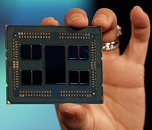Tuesday, November 6th 2018

AMD Zen 2 "Rome" MCM Pictured Up Close
Here is the clearest picture of AMD "Rome," codename for the company's next-generation EPYC socket SP3r2 processor, which is a multi-chip module of 9 chiplets (up from four). While first-generation EPYC MCMs (and Ryzen Threadripper) were essentially "4P-on-a-stick," the new "Rome" MCM takes the concept further, by introducing a new centralized uncore component called the I/O die. Up to eight 7 nm "Zen 2" CPU dies surround this large 14 nm die, and connect to it via substrate, using InfinityFabric, without needing a silicon interposer. Each CPU chiplet features 8 cores, and hence we have 64 cores in total.
The CPU dies themselves are significantly smaller than current-generation "Zeppelin" dies, although looking at their size, we're not sure if they're packing disabled integrated memory controllers or PCIe roots anymore. While the transition to 7 nm can be expected to significantly reduce die size, groups of two dies appear to be making up the die-area of a single "Zeppelin." It's possible that the CPU chiplets in "Rome" physically lack an integrated northbridge and southbridge, and only feature a broad InfinityFabric interface. The I/O die handles memory, PCIe, and southbridge functions, featuring an 8-channel DDR4 memory interface that's as monolithic as Intel's implementations, a PCI-Express gen 4.0 root-complex, and other I/O.
Source:
Tom's Hardware
The CPU dies themselves are significantly smaller than current-generation "Zeppelin" dies, although looking at their size, we're not sure if they're packing disabled integrated memory controllers or PCIe roots anymore. While the transition to 7 nm can be expected to significantly reduce die size, groups of two dies appear to be making up the die-area of a single "Zeppelin." It's possible that the CPU chiplets in "Rome" physically lack an integrated northbridge and southbridge, and only feature a broad InfinityFabric interface. The I/O die handles memory, PCIe, and southbridge functions, featuring an 8-channel DDR4 memory interface that's as monolithic as Intel's implementations, a PCI-Express gen 4.0 root-complex, and other I/O.

71 Comments on AMD Zen 2 "Rome" MCM Pictured Up Close
No more pciex3 or below on the ccx chip , likely just pciex 4 links and no memory controller and all using IF2 protocols.
So mainstream and below will require some level of backwards compatibility and an io chip , though it could be a old school north/south bridge stlye too in reality , not many know and they're tihht lipped but between comments and rumours lie truth ,see adoreds video on rome , he's a tool but he was right somehow.
Edit: oh ain't it fun when the forum decides to paste in the remnants of some discarded half-written post before posting what you just wrote. Sorry about that :p
The real question, in what scenario's have they improved things and we Know:
Throughput.
Density.
Clock speed increase (25%)
Latency consistency.
IPC.
Scalability.
PCI-E G4.
Thought experiment: might we see specialised EPYC offshoots replacing half the CPU chiplets with GPU chiplets? Sure, they'll be memory starved when compared to any HBM2 or GDDR setup, but why not? Or might we see SKUs implementing HBM2 stacks in there too (4 CPU chiplets, 2 GPU chiplets and 2 stacks of HBM2?)? It shouldn't be too hard to run a HBM2 controller off the IF links in the I/O die, after all. Does anyone have an idea of the total bandwidth of a single IF link? Would a single 8-hi stack of 1024-bit 2000MT/s HBM2 saturate it?